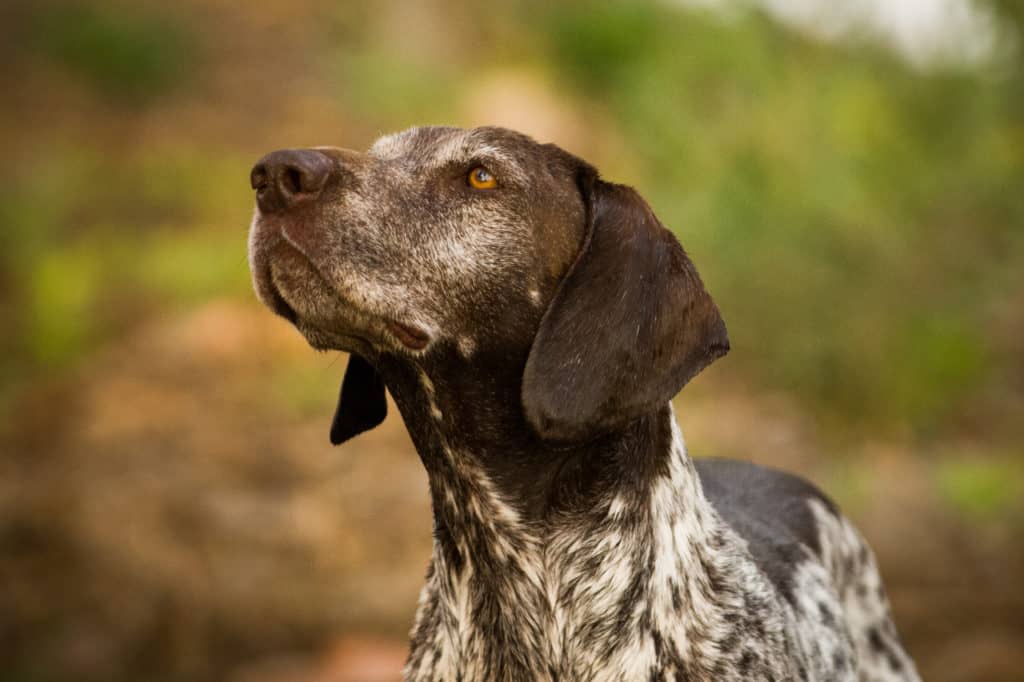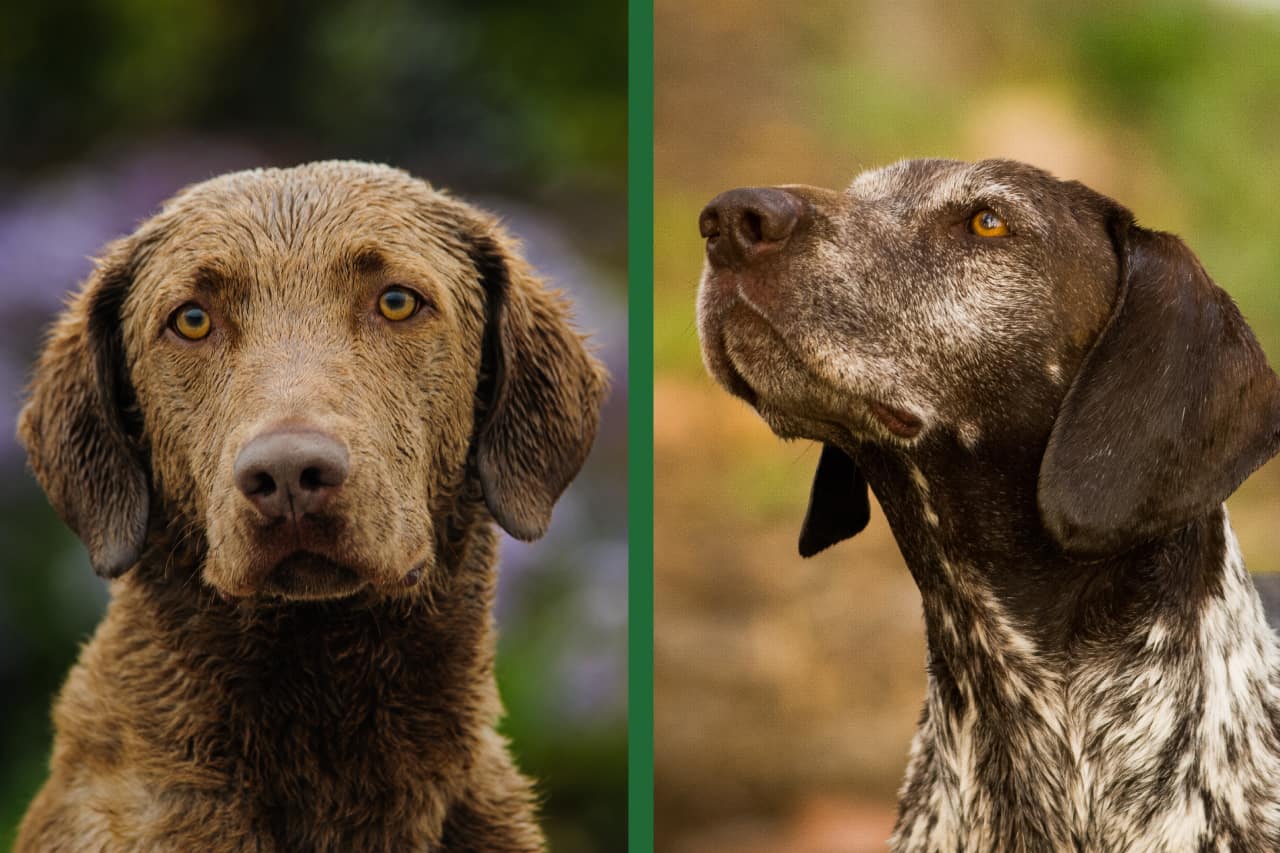Chesapeake Bay Retrievers and German Pointers are amazing breeds for active owners and especially for avid bird hunters. Even though they are both high-maintenance dogs, they are very different, and, therefore, one may be ideal for your home, while the other is less appropriate.
Chesapeake Bay Retrievers are adapted to cold climes. German Pointers are pointing bird dogs and less adapted to cold. Chesapeakes are more stubborn, independent, and aggressive than German Pointers. German Pointers require more exercise than Chesapeakes. German Longhaired Pointers differ most from Chesapeakes.
There are actually three different types of German Pointer. There is the German Longhaired Pointer, the German Shorthaired Pointer, and the German Wirehaired Pointer. They have similarities, but they are different enough to be classified as separate breeds. This article will compare the Chesapeake Bay Retriever to each of these German Pointers.
It should be noted that the details below are based on the breed standards and the most commonly seen behaviors and characteristics. However, there are individual differences. Temperament especially is affected by other factors, such as personality, age, quality of breeding, socialization, training, history, and living environment.
Chesapeake Bay Retriever Vs. German LONGHAIRED Pointer
Classification, Lifespan, And Appearance
| CHESAPEAKE BAY RETRIEVER | GERMAN LONGHAIRED POINTER | |
| AKC Classification | Sporting Group | Foundation Stock Service |
| Alternative Classification | Bird Dog – Retriever | Bird Dog – Pointer |
| Lifespan | 10-13 years | 12-14 years |
| Height | 21-26 inches | 22-28 inches |
| Weight | 55-80 lbs | 55-80 lbs |
| Coat Length | Short | Medium to long |
| Coat Characteristics | Thick and waterproof; wooly undercoat | Sleek with undercoat |
| Feathering | Little to none | Moderate; on ears, back of all legs, and tail |
| Hypoallergenic Coat | No | No |
| Ears | Hang down; short; un-feathered | Hang down; medium to long; feathered |
Summary:
Chesapeake Bay Retrievers are retrieving bird dogs, bred to fetch the birds downed by their human hunting companions. The Chesapeake Bay Retriever is also adapted to retrieve waterfowl, even in colder weather. German Longhaired Pointers are pointing bird dogs, bred to find game and point them out to their hunting companion without disturbing the game until the hunter was in range.
Chesapeake Bay Retrievers are stocky, powerfully built dogs. Their rough outer coat and wooly undercoat sit short and dense all over the dog’s body. They have a no-nonsense, no-frills appearance. German Longhaired Pointers are built along more slender lines but are by no means dainty. Their long, sleek coat is actually only 5 centimeters over most of their body, although they have longer feathering over their ears, tail, and back of their legs.
Grooming Requirements
| CHESAPEAKE BAY RETRIEVER | GERMAN LONGHAIRED POINTER | |
| Maintenance Intensity | Moderate | Moderate |
| Brushing | 2-3 times a week | Weekly |
| Bathing | Occasional | Occasional |
| Shedding | Regular | Infrequent |
| Ears | Checked and cleaned weekly | Checked daily; cleaned weekly; brushed 2-3 time a week |
Summary:
Chesapeake Bay Retrievers have shorter coats that are less likely to pick up debris and become tangled than German Longhaired Pointers’ coats. However, a Chesapeake Bay Retriever’s coat sheds frequently and requires more regular brushing than the German Longhaired Pointer, an infrequent shedder.
The long and feathered ears of the German Longhaired Pointer require more upkeep than those of the Chesapeake Bay Retriever.
Temperament
| CHESAPEAKE BAY RETRIEVER | GERMAN LONGHAIRED POINTER | |
| General Temperament (AKC) | Affectionate; bright; sensitive | Versatile; calm; family-oriented |
| Affectionate (to family) | Yes; often prefers one person | Yes; often prefers one person |
| Independence | Moderate | Low |
| Intensity | High | Moderate |
| Sensitivity | Moderate | Moderate |
| Stubborn | Likely | Unlikely |
| Aggression Level | Moderate | Low |
| Timid | No | Unlikely |
| Energy Level | High | High |
| Attention Requirements | High | High |
| One-Person Dog | Likely | Likely |
| General Friendliness | Moderate | High |
| Child Friendliness | Moderate to high | High |
| Stranger Friendliness | Reserved | Friendly |
| Dog Friendliness | Low | Moderate to high |
| Cat Friendliness | Moderate if raised with them | Low |
| Protectiveness | High | Low to moderate |
| Prey Drive | High | High |
| Barking Potential | Moderate | Moderate |
Summary:
Chesapeake Bay Retrievers are intense and independent dogs with a strong stubborn streak, a proclivity to be more aggressive and protective. However, they should not be inappropriately aggressive. German Longhaired Pointers are more emotionally dependent on their families. They are affectionate and docile (with the right amount of exercise).
Chesapeake Bay Retrievers are reserved with strangers and will not tolerate abuse from children, although their response is to walk away when they have had enough. They also tend not to get along well with other dogs unless they were raised with them. German Longhaired Pointers are friendly with strangers, children, and other dogs.
Exercise And Training Requirements
| CHESAPEAKE BAY RETRIEVER | GERMAN LONGHAIRED POINTER | |
| Socialization | Required | Required |
| Intelligence Level | High | High |
| Endurance | Moderate to high | High |
| Eager to Please | Moderate | High |
| Exercise Needs | Moderate to high | High |
| Exercise Frequency | 1-2 times a day | 2-3 times a day |
| Exercise Duration | Min. 20 minutes per session | 30-60 minutes per session |
| Exercise Intensity | High | Moderate to high |
| Owner Requirements | Active | Active |
| Exercise Companion | Good; needs to build up endurance | Good |
| Training Methods | Positive preferred; needs firm and consistent guidance | Positive preferred |
| Mandatory Training | Obedience | Obedience |
| Canine Sport Training | Encouraged | Eligible |
| Affinity for Water | High | High |
Summary:
Chesapeake Bay Retrievers thrive when they have a task to do and can become restive without purposeful training and exercise. This makes them ideal candidates for canine sports. German Longhaired Pointers are happy with lots of yard play.
The stubborn streak of the Chesapeake Bay Retriever means that they require a strong and confident hand for training and exercise. German Longhaired Pointers are eager to please and intelligent, making them relatively easy to train.
German Longhaired Pointers have more demanding exercise requirements, although the Chesapeake Bay Retrievers still need plenty of exercise.
Adaptability And Living Environment
| CHESAPEAKE BAY RETRIEVER | GERMAN LONGHAIRED POINTER | |
| Good for First-Time Owners | No | Possibly |
| Good for Single-Person Homes | Yes | Yes |
| Good for Multi-Person Homes | Possibly | Yes |
| Alone Time | Intolerant of extended periods of isolation | Intolerant |
| Indoor Living | Should be allowed indoors with family; not suitable for apartment living | Should be allowed indoors with family; not suitable for apartment living |
| Outdoor Requirements | Should have access to a secure yard; should be taken outside each day | Should have access to a secure yard; should be taken outside each day |
| Toleration of Cold Weather | High | Moderate |
| Toleration of Hot Weather | Moderate to high | Low to moderate |
Summary:
Chesapeake Bay Retrievers are not suitable for novice owners. They are strong-willed and dominant and will take advantage of an unsure or inexperienced owner. German Longhaired Pointers are more suitable for novice owners, but they are still very high maintenance dogs that would require a particular novice owner.
German Longhaired Pointers are adapted to multi-person homes as they are happy to get involved in the lives of all family members. The Chesapeake Bay Retriever is more likely to be a one-person dog. They can still get along with the other members of the family, but they display a definite preference for their chosen human.
Both dogs are intolerant of being left alone, but, owing to its independent streak, the Chesapeake Bay Retriever is likely to do better with short periods of isolation than the German Longhaired Pointer.
While the German Longhaired Pointer is more adapted for cold weather than its shorthaired and wirehaired counterparts, it is less adapted than the Chesapeake Bay Retriever, who thrives in the cold.

Chesapeake Bay Retriever Vs. German SHORTHAIRED Pointer
Classification, Lifespan, And Appearance
| CHESAPEAKE BAY RETRIEVER | GERMAN SHORTHAIRED POINTER | |
| AKC Classification | Sporting Group | Sporting Group |
| Alternative Classification | Bird Dog – Retriever | Bird Dog – Pointer |
| Lifespan | 10-13 years | 10-12 years |
| Height | 21-26 inches | 21-25 inches |
| Weight | 55-80 lbs | 45-70 lbs |
| Coat Length | Short | Very short |
| Coat Characteristics | Thick with wooly undercoat | Thick and coarse on body; thinner and softer on head and ears |
| Feathering | Little to none | None |
| Hypoallergenic Coat | No | No |
| Ears | Hang down; short; un-feathered | Hang down; medium to long; un-feathered |
Summary:
Chesapeake Bay Retrievers are retrieving bird dogs adapted for working in colder climes. German Shorthaired Pointers are pointing bird dogs.
Chesapeake Bay Retrievers have a wooly undercoat, whereas the German Shorthaired Pointer has only a topcoat.
Grooming Requirements
| CHESAPEAKE BAY RETRIEVER | GERMAN SHORTHAIRED POINTER | |
| Maintenance Intensity | Moderate | Moderate |
| Brushing | 2-3 times a week | Occasional |
| Bathing | Occasional | Occasional |
| Shedding | Regular | Regular |
| Ears | Checked and cleaned weekly | Checked and cleaned weekly |
Summary:
The Chesapeake Bay Retriever requires more regular brushing than the German Shorthaired Pointer.
Temperament
| CHESAPEAKE BAY RETRIEVER | GERMAN SHORTHAIRED POINTER | |
| General Temperament (AKC) | Affectionate; bright; sensitive | Friendly; smart; willing to please |
| Affectionate (to family) | Yes; often prefers one person | Yes; often prefers one person |
| Independence | Moderate | Moderate |
| Intensity | High | Moderate to high |
| Sensitivity | Moderate | Moderate to high |
| Stubborn | Likely | Possible |
| Aggression Level | Moderate | Low |
| Timid | No | No |
| Energy Level | High | High |
| Attention Requirements | High | High |
| One-Person Dog | Likely | Likely |
| General Friendliness | Moderate | Moderate |
| Child Friendliness | Moderate to high | Moderate to high; better with older children |
| Stranger Friendliness | Reserved | Reserved to friendly |
| Dog Friendliness | Low | Low |
| Cat Friendliness | Moderate if raised with them | Low |
| Protectiveness | High | Moderate to high |
| Prey Drive | High | High |
| Barking Potential | Moderate | Moderate |
Summary:
The Chesapeake Bay Retriever and German Shorthaired Pointer are more similar when it comes to temperament than are the Chesapeake and the German Longhaired.
Chesapeake Bay Retrievers are more aggressive than the German Shorthaired Pointer, but they should not be excessively aggressive.
The Chesapeake Bay Retriever is better with cats (that it was raised with), while the German Shorthaired Pointer has a very high prey drive and is unlikely to be suitable for a house where cats are already living.
Exercise And Training Requirements
| CHESAPEAKE BAY RETRIEVER | GERMAN SHORTHAIRED POINTER | |
| Socialization | Required | Required |
| Intelligence Level | High | High |
| Endurance | Moderate to high | High |
| Eager to Please | Moderate | High |
| Exercise Needs | Moderate to high | High |
| Exercise Frequency | 1-2 times a day | 2-3 times a day |
| Exercise Duration | Min. 20 minutes per session | 30-60 minutes per session |
| Exercise Intensity | High | Moderate to high |
| Owner Requirements | Active | Active |
| Exercise Companion | Good; needs to build up endurance | Excellent |
| Training Methods | Positive preferred; needs firm and consistent guidance | Positive yields best results; shorter duration is better |
| Mandatory Training | Obedience | Obedience |
| Canine Sport Training | Encouraged | Encouraged |
| Affinity for Water | High | Moderate to high |
Summary:
German Shorthaired Pointers have a stronger eagerness to please than the Chesapeake Bay Retriever, but they are still strong-minded, so you need to be intentional about how you train them.
Chesapeake Bay Retrievers require ample exercise, but not as much as the German Shorthaired Pointer needs.
Adaptability And Living Environment
| CHESAPEAKE BAY RETRIEVER | GERMAN SHORTHAIRED POINTER | |
| Good for First-Time Owners | No | No |
| Good for Single-Person Homes | Yes | Yes (if person can meet their exercise requirements) |
| Good for Multi-Person Homes | Possibly | Yes |
| Alone Time | Intolerant of extended periods of isolation | Intolerant |
| Indoor Living | Should be allowed indoors with family; not suitable for apartment living | Should be allowed indoors with family; not suitable for apartment living |
| Outdoor Requirements | Should have access to a secure yard; should be taken outside each day | Should have access to a secure yard; should be taken outside each day |
| Toleration of Cold Weather | High | Low |
| Toleration of Hot Weather | Moderate to high | Moderate to high |
Summary:
Both dogs are intolerant of being left alone, but the Chesapeake Bay Retriever is likely to do better with short periods of isolation than the German Shorthaired Pointer.
The Chesapeake Bay Retriever is much more tolerant of cold weather than the German Shorthaired Pointer.

Chesapeake Bay Retriever Vs. German WIREHAIRED Pointer
Classification, Lifespan, And Appearance
| CHESAPEAKE BAY RETRIEVER | GERMAN WIREHAIRED POINTER | |
| AKC Classification | Sporting Group | Sporting Group |
| Alternative Classification | Bird Dog – Retriever | Bird Dog – Pointer |
| Lifespan | 10-13 years | 14-16 years |
| Height | 21-26 inches | 22-26 inches |
| Weight | 55-80 lbs | 50-70 lbs |
| Coat Length | Short | Short (longer on belly) |
| Coat Characteristics | Thick with wooly undercoat | Straight, harsh, and wiry; undercoat is dense in winter and thin in summer |
| Feathering | Little to none | Little to none |
| Hypoallergenic Coat | No | No |
| Ears | Hang down; short; un-feathered | Hang down; short to medium; un-feathered |
Summary:
Chesapeake Bay Retrievers are retrieving bird dogs adapted for working in colder climes. German Shorthaired Pointers are pointing bird dogs.
Neither of these dogs has a smooth, silky coat, but the German Wirehaired Pointer has the harsher coat. Both have undercoats, but the German Wirehaired Pointer’s undercoat has seasonal variations in thickness.
Grooming Requirements
| CHESAPEAKE BAY RETRIEVER | GERMAN WIREHAIRED POINTER | |
| Maintenance Intensity | Moderate | Low |
| Brushing | 2-3 times a week | Weekly |
| Bathing | Occasional | Occasional |
| Shedding | Regular | Regular |
| Ears | Checked and cleaned weekly | Checked and cleaned weekly |
Summary:
The Chesapeake Bay Retriever requires more grooming overall than the German Wirehaired Pointer.
Temperament
| CHESAPEAKE BAY RETRIEVER | GERMAN WIREHAIRED POINTER | |
| General Temperament (AKC) | Affectionate; bright; sensitive | Affectionate; eager; enthusiastic |
| Affectionate (to family) | Yes; often prefers one person | Yes; often prefers one person |
| Independence | Moderate | Moderate |
| Intensity | High | Moderate to high |
| Sensitivity | Moderate | Moderate to high |
| Stubborn | Likely | Possible |
| Aggression Level | Moderate | Moderate (dog aggression) |
| Timid | No | No |
| Energy Level | High | High |
| Attention Requirements | High | High |
| One-Person Dog | Likely | Likely |
| General Friendliness | Moderate | High |
| Child Friendliness | Moderate to high | High (can be too boisterous) |
| Stranger Friendliness | Reserved | Reserved |
| Dog Friendliness | Low | Low |
| Cat Friendliness | Moderate if raised with them | Low |
| Protectiveness | High | High |
| Prey Drive | High | High |
| Barking Potential | Moderate | Moderate |
Summary:
The Chesapeake Bay Retriever and German Wirehaired Pointer are more similar when it comes to temperament than are the Chesapeake and the German Longhaired.
The Chesapeake Bay Retriever is better with cats (that it was raised with), while the German Wirehaired Pointer has a very high prey drive and is unlikely to be suitable for a house where small pets are already living.
Exercise And Training Requirements
| CHESAPEAKE BAY RETRIEVER | GERMAN WIREHAIRED POINTER | |
| Socialization | Required | Required |
| Intelligence Level | High | High |
| Endurance | Moderate to high | High |
| Eager to Please | Moderate | High |
| Exercise Needs | Moderate to high | High |
| Exercise Frequency | 1-2 times a day | 2-3 times a day |
| Exercise Duration | Min. 20 minutes per session | 30-60 minutes per session |
| Exercise Intensity | High | High |
| Owner Requirements | Active | Active |
| Exercise Companion | Good; needs to build up endurance | Excellent |
| Training Methods | Positive preferred; needs firm and consistent guidance | Positive preferred |
| Mandatory Training | Obedience | Obedience |
| Canine Sport Training | Encouraged | Encouraged |
| Affinity for Water | High | High |
Summary:
The German Wirehaired Pointer has extremely demanding exercise requirements. The Chesapeake Bay Retriever still needs ample exercise, but not near as much.
Adaptability And Living Environment
| CHESAPEAKE BAY RETRIEVER | GERMAN WIREHAIRED POINTER | |
| Good for First-Time Owners | No | No |
| Good for Single-Person Homes | Yes | Yes |
| Good for Multi-Person Homes | Possibly | Yes |
| Alone Time | Intolerant of extended periods of isolation | Intolerant of extended periods of isolation |
| Indoor Living | Should be allowed indoors with family; not suitable for apartment living | Should be allowed indoors with family; not suitable for apartment living |
| Outdoor Requirements | Should have access to a secure yard; should be taken outside each day | Should have access to a secure yard; should be taken outside each day |
| Toleration of Cold Weather | High | Moderate to high |
| Toleration of Hot Weather | Moderate to high | Moderate to high |
Summary:
Chesapeake Bay Retrievers are less likely to need or desire the company of anyone other than their chosen person. In contrast, a German Wirehaired Pointer will still be happy to interact with each family member, even with a favorite.
Chesapeake Bay Retrievers tolerate the cold slightly better than the German Wirehaired Pointer.
Conclusion
There are three different breeds of German Pointer. The German Longhaired Pointer differs from the Chesapeake Bay Retriever in more ways than the German Shorthaired Pointer and German Wirehaired Pointer.
Chesapeake Bay Retrievers are affectionate with their family but are not a dog who should be pushed. They have a tendency towards aggression, but this should never be excessive and is directed into reservation with strangers and protection of their family.
German Pointers are less aggressive overall, although the Wirehaired Pointer displays dog-dog aggression. German Pointers are less protective but not unprotective.
German Pointers have higher energy and exercise requirements than the Chesapeake Bay Retrievers.
All of these breeds are not appropriate for novice owners. They require strong-minded owners who are extremely active and will invest lots of time and effort into training and exercising their dogs.
References
https://dogtime.com/dog-breeds/german-longhaired-pointer#/slide/1
https://www.akc.org/dog-breeds/german-longhaired-pointer/
https://www.ukcdogs.com/german-long-haired-pointer
https://www.wildfowlmag.com/editorial/how-to-pick-the-right-puppy/280276
https://www.thesprucepets.com/chesapeake-bay-retriever-full-profile-history-and-care-4693502
https://www.orvis.com/chesapeake-bay-retriever
https://dogtime.com/dog-breeds/chesapeake-bay-retriever#/slide/1
https://www.akc.org/dog-breeds/chesapeake-bay-retriever/
https://www.ukcdogs.com/chesapeake-bay-retriever
https://www.akc.org/dog-breeds/german-shorthaired-pointer/
https://www.orvis.com/german-shorthaired-pointer
https://dogtime.com/dog-breeds/german-shorthaired-pointer#/slide/1
https://dogtime.com/dog-breeds/german-wirehaired-pointer#/slide/1

